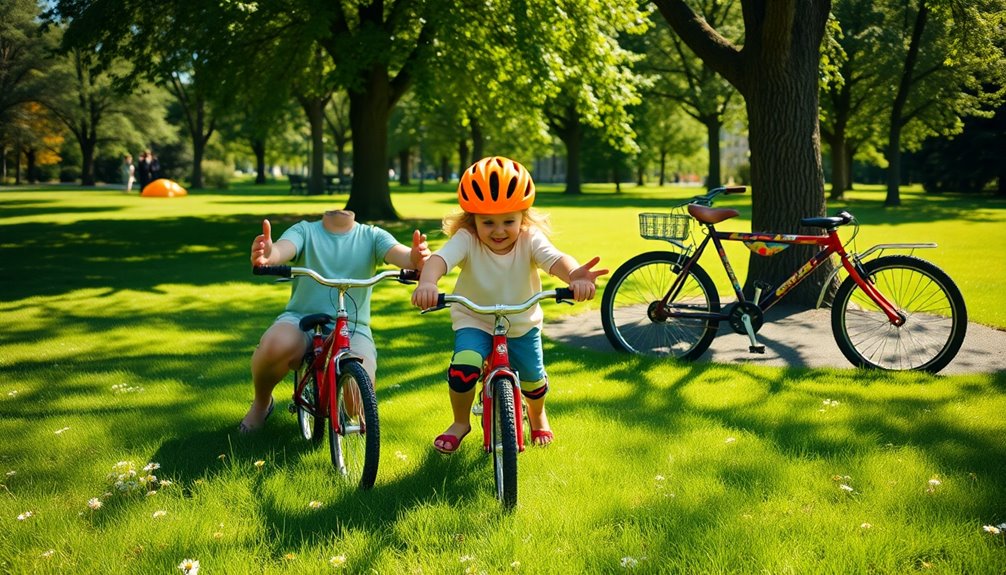Learning to ride a bike on a budget is totally achievable. Start by selecting a reliable used bike, ideally a mountain or women's frame, which you can find for $150-$200. Don't forget essential gear like a safety-certified helmet, which can be as low as $10. Invest in basic maintenance tools and a portable pump to handle any emergencies. Staying hydrated and fueling up with affordable snacks helps keep your energy up. Explore local trails and join a cycling community for support and tips. Keep going, and you'll discover even more tricks to make your cycling journey enjoyable!
Selecting the Right Bike
When you're immersing yourself in the world of cycling, picking the right bike can make all the difference. For beginners, a mountain bike is an excellent choice. Its stability and wider tires give you better control, making your riding experience smoother and more enjoyable.
When selecting a bike, consider opting for a women's or mixte frame. This design makes mounting and dismounting easier, especially if you're just starting out. Additionally, using a budget management tool can help you keep track of any cycling-related expenses as you invest in your new hobby. Leveraging expense management apps can further streamline your budgeting process and enhance financial organization.
If you're on a budget, don't overlook used bikes. You can often find quality options for $150-$200, allowing you to jump into cycling without breaking the bank. Just make certain to check that the brakes function properly and provide good modulation; this is essential for your safety while riding.
Once you narrow down your choices, visit a local bike shop for a proper bike fit. This guarantees the bike feels comfortable and performs well, making your rides more enjoyable. A well-fitted bike can greatly enhance your cycling experience, so take the time to get it right. Remember, the right bike sets the foundation for your cycling journey!
Essential Safety Gear
When you hit the road on your bike, safety gear is a must.
Wearing a certified helmet can drastically cut your risk of head injuries, while reflective clothing keeps you visible to others, especially in low-light conditions. Additionally, establishing a routine for checking payment alerts can help you manage your bike-related expenses effectively. Choosing gear made from sustainable materials not only enhances your safety but also supports eco-friendly practices.
Don't forget to equip your bike with front and rear lights to guarantee you're seen at night. Additionally, considering sustainable packaging solutions for any bike accessories you purchase can enhance your commitment to eco-friendly practices while cycling.
Importance of Helmets
Wearing a helmet is one of the smartest decisions you can make as a cyclist. It reduces your risk of head injury by up to 85% in case of a crash, making it an essential piece of safety gear for everyone, regardless of age.
When you choose bike helmets, look for those that meet safety standards like the CPSC certification; these helmets are designed to absorb impact effectively.
Make certain your helmet is properly fitted. It should sit level on your head, with the front edge just above your eyebrows, and shouldn't move more than an inch in any direction when adjusted. This guarantees maximum protection while you're out cycling.
You don't have to spend a lot to keep your head safe. Many affordable helmet options start as low as $10, providing adequate protection without straining your budget.
Just remember to inspect your helmet regularly for signs of wear or damage, and replace it every 3-5 years or after any significant impact. Prioritizing safety gear like a helmet will help you enjoy your rides with peace of mind.
Reflective Clothing Benefits
Reflective clothing plays an indispensable role in enhancing your visibility as a cyclist, especially during low-light conditions. When you wear reflective gear, you can increase your visibility by up to 200% at night, greatly reducing the risk of accidents. This is essential for your safety during evening rides, as it makes you more noticeable to motorists.
Many cycling clothing options feature high-visibility colors like bright yellow or orange, which boost your visibility even during the day or in poor weather. Additionally, reflective strips or patterns on your clothing help guarantee you're seen from all angles, improving safety at intersections and while maneuvering through traffic.
Investing in quality reflective gear is a smart, budget-friendly choice. Often priced similarly to standard cycling apparel, it provides an effective safety measure without breaking the bank.
As a beginner cyclist, prioritizing your visibility is fundamental for your overall safety on the road. By choosing reflective clothing, you not only enhance your own safety but also contribute to safer cycling environments for everyone.
Essential Lighting Gear
Proper lighting gear is essential for every cyclist, especially during nighttime rides. Investing in good front and rear bike lights can greatly boost your visibility and safety. You can find quality sets for as little as $15-$30, making it easy to equip your cheap bike without breaking the bank.
Here are some essential lighting gear tips to keep in mind:
- Choose lights with multiple settings (steady and flashing) to grab attention.
- Use reflective gear, like vests or armbands, to enhance visibility up to 300 feet.
- Opt for rechargeable lights via USB for convenience and cost-effectiveness.
- Always check your lights before every ride to verify they're functioning properly.
- Consider pairing your lights with a helmet-mounted light for added safety.
Affordable Cycling Apparel
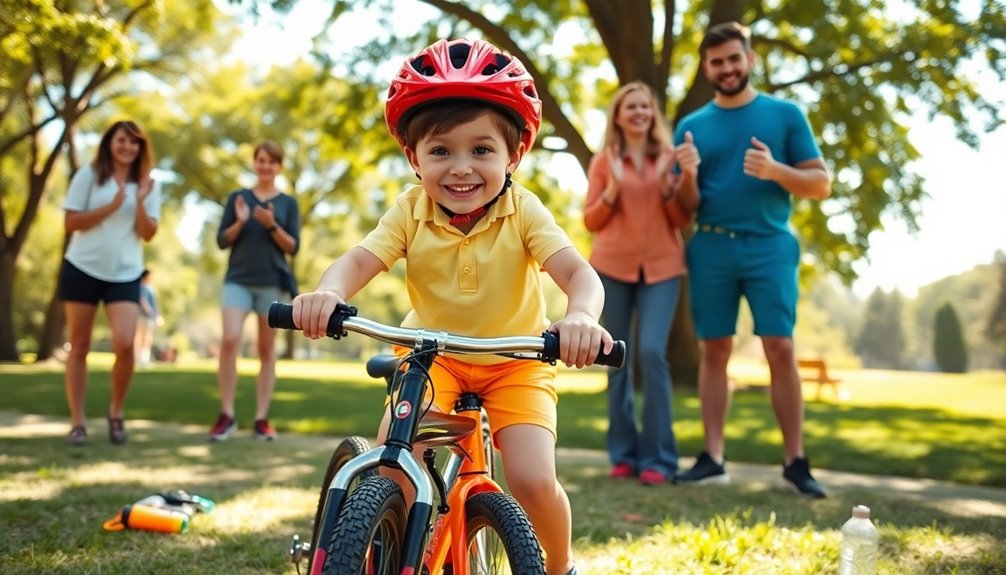
Finding affordable cycling apparel can make a considerable difference in your ride experience, especially if you're just starting out. You don't need to splurge on high-end brands to stay comfortable and stylish on your bike.
Consider looking into options from brands like Aero Tech Designs and Baleaf, which offer quality garments at reasonable prices. Budget apps can assist you in tracking expenses related to your cycling gear, ensuring you stay within your financial limits. Using these apps can provide valuable spending insights to help you make informed decisions about your purchases.
If you're keen to save money, thrift shops and yard sales can be treasure troves for used cycling clothing. You can often find functional gear that fits your needs without breaking the bank.
Additionally, keep an eye out for sales during major shopping events; discounts on cycling apparel can greatly cut costs.
While basic activewear can work for beginners, investing in padded cycling shorts—around $20—can enhance your comfort during longer rides.
Just remember to avoid extremely cheap options that compromise quality and durability. It's better to invest in a few essential, well-made pieces that will last.
Incorporating resources like budgeting apps can also help you manage your spending on cycling gear effectively.
With a little patience and creativity, you can assemble an affordable cycling wardrobe that'll keep you comfortable and looking good on every ride.
Basic Bike Maintenance
Keeping your bike in top shape is essential for a smooth and enjoyable ride. Regular maintenance not only enhances performance but also guarantees your safety on the road.
Here are some basic bike maintenance tips to keep you rolling:
- Inspect and clean your bike: Use hot soapy water to wash it and dry it properly to prevent dirt build-up. Regular cleaning can also help you identify potential issues before they become serious problems.
- Lubricate the chain: Apply lubricant every 100-150 miles or whenever it looks dry to avoid annoying creaks and extend its lifespan. Regular lubrication also enhances accuracy in shifting, improving overall performance.
- Check tire pressure: Always verify the pressure before each ride, as the ideal level is marked on the tire's sidewall and influences safety and performance.
- Carry a repair kit: Equip yourself with tire levers, patches, and a mini pump to handle flat tires. This can save you from being stranded.
- Master shifting techniques: Anticipate terrain changes and shift gears proactively to maintain an efficient pedaling cadence, reducing strain on your bike.
- To keep track of your bike maintenance expenses, consider using an expense tracking app to streamline financial management.
Nutrition for Cyclists
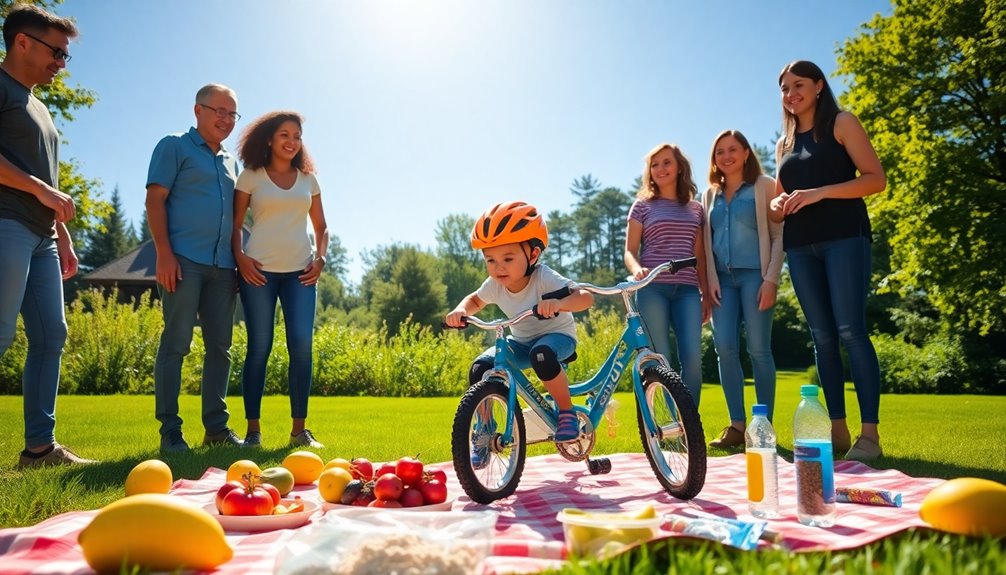
When you're out on a long ride, fueling your body properly is essential to maintain energy and performance. Staying hydrated is key, so aim to drink water regularly, and consider using hydration packs for those extended distances. Digital coupons can also help you save on nutritious snacks that keep your energy levels up during rides.
To prevent "bonking," munch on easily digestible snacks like energy bars or gels, consuming 100-250 calories every 30 minutes. This strategy keeps your energy levels stable and helps you power through your ride. Additionally, incorporating AI-driven tools for meal planning can optimize your nutrition based on your cycling routine.
Don't forget about electrolytes! They're vital for preventing cramping, particularly in hot weather. You can make homemade electrolyte drinks that are both cost-effective and beneficial. Utilizing digital coupons can also provide savings on electrolyte products.
After your ride, focus on post-ride recovery by incorporating a mix of carbohydrates and protein. A smoothie or a whole grain sandwich can be great options to help your muscles recover.
Lastly, plan your meals around nutrient-dense foods. Prioritizing fruits, vegetables, lean proteins, and whole grains will enhance your overall nutrition, boosting your endurance and cycling performance. Additionally, making ethically informed choices in your food selection can also promote sustainability and support fair treatment of workers in the food industry.
Riding Techniques for Beginners
Mastering riding techniques is essential for beginners enthusiastic to gain confidence on two wheels. Start by practicing your balance in a grassy field. Coasting down a slight hill without pedaling helps build stability.
Here are some tips to enhance your riding experience:
- Adjust the seat height so your feet can touch the ground comfortably, aiding balance.
- Maintain a brisk pace while riding; going too slow can make balancing difficult.
- Focus on looking ahead, not down at the pedals, to help with balance and steering.
- Gradually progress from coasting to pedaling; keep your body relaxed to shift your weight during turns.
- If you need guidance, a bike shop can help you with adjustments and tips.
If you're considering a second-hand bike, verify it's the right fit for your height and skill level.
Practicing these techniques won't only improve your balance but also boost your confidence. Embrace the process and enjoy your journey toward mastering the art of riding!
Understanding Cycling Etiquette
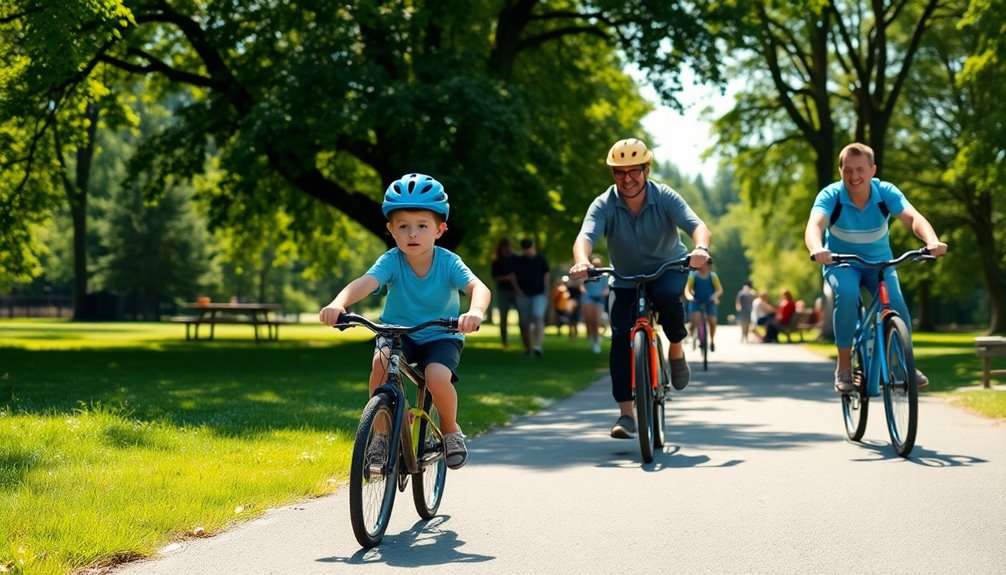
As you become more comfortable riding, understanding cycling etiquette is vital for ensuring a safe and enjoyable experience for everyone on the road.
Start by maintaining a straight line while riding; this helps keep you predictable and allows others to navigate around you safely. When you're out with a cycling club or other riders, communicate your intentions clearly. Use verbal signals or hand gestures to indicate turns and stops, making it easier for everyone to stay coordinated.
Keep a safe distance from other riders to prevent overlapping wheels, which can lead to accidents. If you notice a faster rider approaching, respect their pace by allowing them to pass safely without disrupting the flow of the group.
During group rides, it's important to follow the established pace, avoiding unnecessary accelerations that can create gaps and cause confusion.
Group Riding Benefits
Group riding offers numerous benefits that can enhance your cycling experience, especially if you're just starting out.
Joining group rides creates a supportive environment where beginner cyclists can gain confidence and improve their skills alongside more experienced riders.
Here are some key advantages of participating in group rides:
- Enhanced Safety: Larger groups increase visibility on the road, making it safer for everyone involved.
- Steady Pace: Riding with others helps maintain a consistent pace, making longer rides more manageable.
- Affordable Learning: Many cycling clubs offer free group rides, allowing you to engage with the cycling community without breaking the bank.
- Skill Development: You can learn essential cycling techniques and tips from seasoned cyclists in a friendly setting.
- Social Connections: Group rides foster friendships and camaraderie, motivating you to continue cycling regularly.
Cost-Effective Accessories
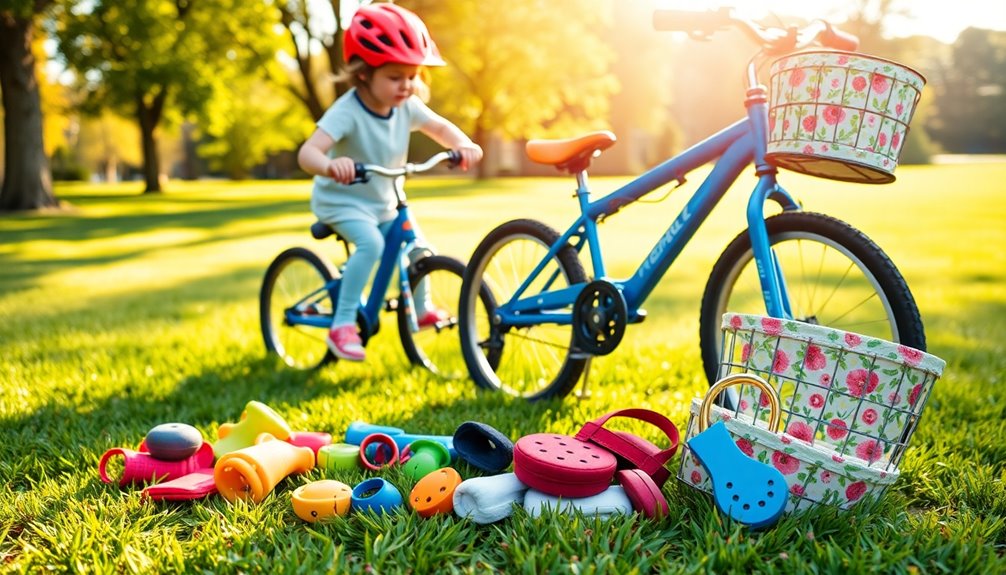
Joining a cycling group not only boosts your skills but also opens up opportunities to learn about cost-effective accessories that can enhance your riding experience.
To stay prepared, invest in a basic multi-tool for around $10-$20. This handy tool helps you tackle minor repairs and adjustments on the go. A portable pump, priced between $15-$30, is essential for quickly fixing flat tires, so you won't get stranded during your rides.
Don't forget about safety; a helmet meeting safety standards can be found for as low as $15. Additionally, consider a simple saddle bag or under-seat pouch for about $10-$20. This will help you carry essential items like a spare tube, tire levers, and a patch kit, ensuring you have what you need during emergencies.
Lastly, invest in reflective clothing and accessories, available for $10-$30, to enhance your visibility and safety, especially in low-light conditions.
Exploring Local Trails
Exploring local trails is an exciting way to enhance your biking skills while enjoying the great outdoors. By venturing onto these paths, you not only get to practice your riding but also connect with your community.
Many areas offer designated bike paths that are free to access, making it budget-friendly for beginners. Here are some tips to make the most of your trail exploration:
- Use apps like Trailforks or AllTrails for detailed maps and reviews.
- Look for beginner-friendly trails in local parks, which are typically flat and well-maintained.
- Visit local bike shops or community centers for trail maps highlighting beginner routes and safety tips.
- Consider joining a cycling club or group; they often organize guided rides to help you learn from experienced cyclists.
- Don't forget to share your experiences and favorite trails with fellow beginners!
Weather Considerations for Cycling
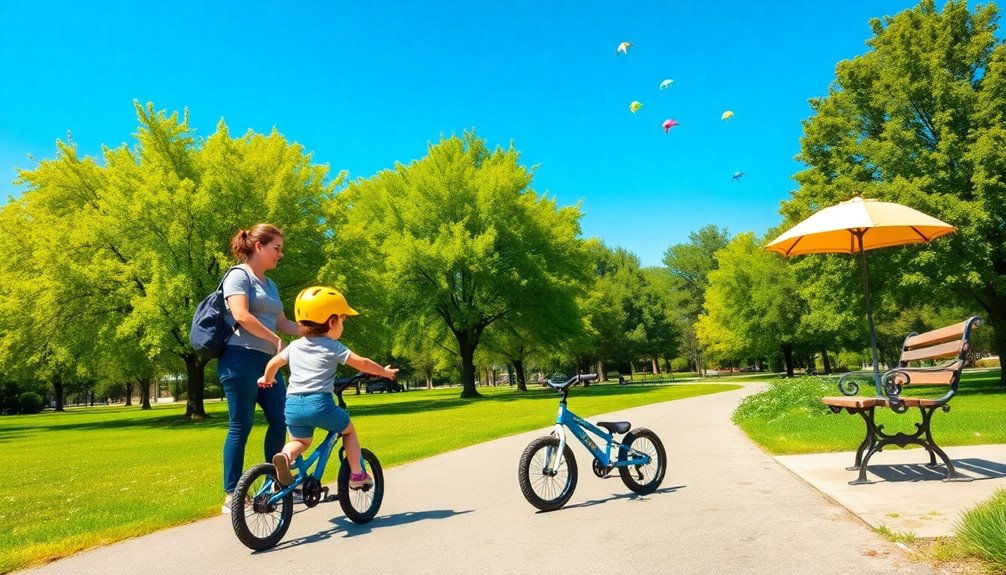
When you're out enjoying local trails, it's important to keep weather conditions in mind to guarantee a safe and comfortable ride. Dressing in layers is essential, as it helps you adapt to changing temperatures while you ride. This way, you can easily add or remove layers to maintain your comfort.
If rain clouds are looming, don't forget to wear waterproof gear like a rain jacket and fenders; staying dry will make your ride much more enjoyable. Avoid riding in extreme weather, such as heavy rain or strong winds, as these conditions can compromise your safety.
Be particularly cautious of slippery surfaces after rain or during winter; slowing down will help you maintain control of your bike. On sunny days, protect your skin by wearing UV-protective clothing and applying sunscreen, especially for long rides.
These small steps can greatly enhance your cycling experience while ensuring the necessary maintenance on your bike is prioritized. Always check the weather forecast before you head out, so you can prepare accordingly and enjoy your ride, no matter the conditions!
Building a Cycling Community
In the vibrant world of cycling, building a community around this shared passion can greatly enhance your experience on two wheels. Engaging with others not only boosts your confidence but also helps you develop essential skills.
Here are some effective ways to foster connections within the cycling community:
- Join local cycling clubs for access to group rides and mentorship.
- Participate in community events or workshops to learn essential cycling techniques and safety tips.
- Engage with online forums and social media groups for advice, resources, and motivation from fellow cyclists.
- Visit local bike shops, which often host group rides or clinics, providing opportunities to meet other cyclists.
- Collaborate with others to share experiences and learn from one another, leading to lifelong friendships.
Conclusion
To sum up, learning to ride a bike on a budget is like discovering a hidden path in a familiar forest—exciting and rewarding. By selecting the right bike, investing in safety gear, and connecting with fellow cyclists, you'll enjoy every pedal stroke without breaking the bank. Embrace the journey, explore local trails, and savor the freedom that cycling offers. With these budget-friendly tips, you're not just saving money; you're also cultivating a lifelong passion for cycling.

